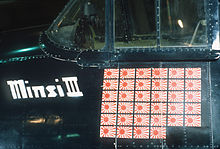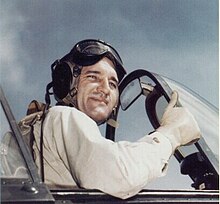David McCampbell
David McCampbell (born January 16, 1910 in Bessemer Alabama , † June 30, 1996 in Florida ) was an American naval aviator and with 34 kills in World War II the pilot with the most kills in the United States Navy .
Life
McCampbell was born in Bessemer, Alabama and raised in West Palm Beach . He attended the Staunton Military Academy, Staunton , Virginia , the Georgia Institute of Technology for a year and then the United States Naval Academy , which he graduated in 1933. Between 1935 and 1937 he served on the cruiser USS Portland , then he applied for pilot training, which he successfully completed a year later. He was stationed with the Fighting Squadron Four on the USS Ranger on the east coast, the squadron was transferred to the Wasp in 1940 , where McCampbell temporarily also asLanding Signal Officer was deployed. After the sinking of the Wasp in September 1942, he was employed as an instructor in the United States, and in August 1943 preparations began for the formation of Fighting Squadron 15, which he commanded until February 1944. From February 1944 he took over command of Air Group 15 , and from spring 1944 he took over command of the entire air group of the aircraft carrier USS Essex . On May 19, McCampbell flew his first mission as commander, the air group attacked Japanese positions on Marcus Island . McCampbell recorded his first kill on June 11th via Saipan . During the Battle of the Philippine Sea he had seven kills in one day, making him a flying ace in one day. By September 1944 he had 19 kills. In the sea and air battle in the Gulf of Leyte , McCampbell attacked a formation of 60 Japanese aircraft with only one wingman, which were heading for the American carrier association. He shot down nine planes and damaged six more, the highest number of kills by a single pilot in a single day.

After returning to the United States in early 1945, McCampbell was personally awarded the Medal of Honor by President Roosevelt , he also received a Silver Star , the Navy Cross , the Legion of Merit and the Distinguished Flying Cross . Between March 1945 and January 1947, McCampbell was Chief of Staff of Commander Fleet Air and Commander in Chief of Carrier Air Groups. He then studied again at Armed Forces Staff College in Norfolk . From 1948 to January 1951 he then worked as a consultant for the Argentine Navy. In March 1951 McCampbell was transferred to the USS Franklin D. Roosevelt as Executive Officer , where he stayed for a year. He was then a planning officer on the staff of Commander Aircraft Atlantic. In the summer of 1953 he was appointed in command of the Naval Air Technical Training Center in Jacksonville , and a year later he was appointed Flight Test Coordinator at the Naval Air Test Center in Maryland . In the following years he took command of the tanker USS Severn and the aircraft carrier USS Bon Homme Richard . In 1960 he was appointed to the Joint Chiefs of Staff , in 1962 he became deputy chief of staff to the Commander in Chief of the Continental Air Defense Command. McCampbell held this post until his retirement in 1964.
McCampbell died on June 30, 1996 in Florida after a long illness. He is buried in Arlington National Cemetery. The US Navy named the guided missile destroyer USS McCampbell after him, and a terminal at Palm Beach International Airport was named after him.
Web links
- Biography (English)
- David McCampbell in the National Aviation Hall of Fame (English)
- Grave of David McCampbell (English)
Individual evidence
- ↑ a b acepilots.com , as of January 11, 2008
| personal data | |
|---|---|
| SURNAME | McCampbell, David |
| BRIEF DESCRIPTION | American naval aviator |
| DATE OF BIRTH | January 16, 1910 |
| PLACE OF BIRTH | Bessemer Alabama |
| DATE OF DEATH | June 30, 1996 |
| Place of death | Florida |
